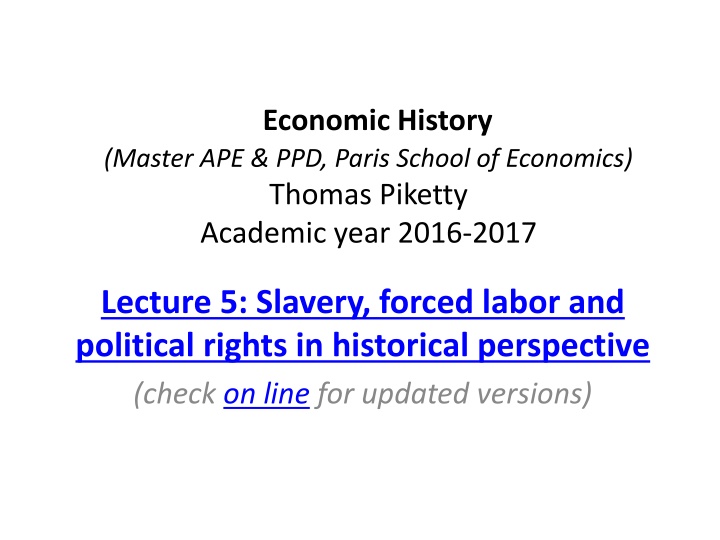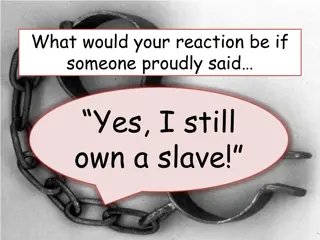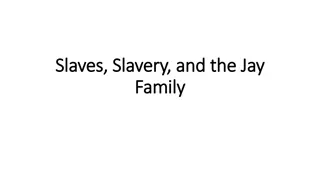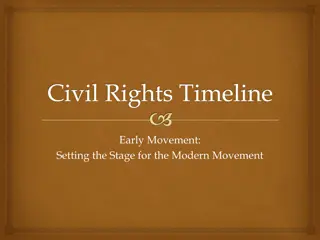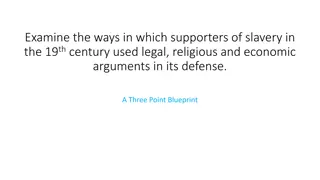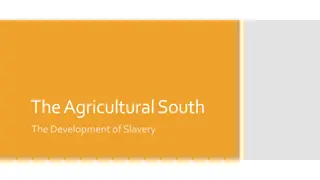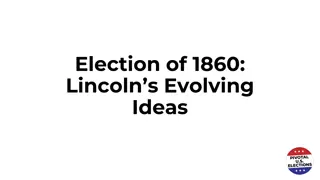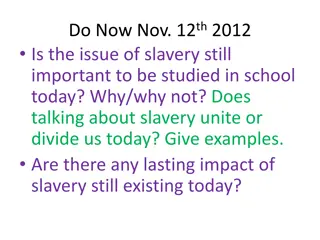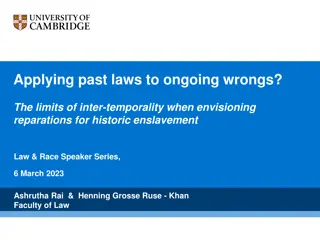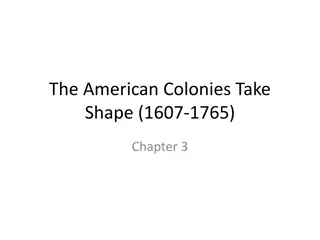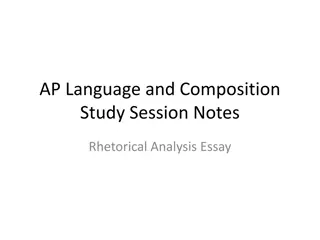Historical Perspective on Slavery: Impact and Relevance
Explore the historical context of slavery, from Ancient Greece and Rome to the pre-1860 Southern US, and its long-term implications on societies. Delve into the debates on compensation, racial discrimination, and the comparison with debt and serfdom, shedding light on the continuum between slavery and freedom.
Download Presentation

Please find below an Image/Link to download the presentation.
The content on the website is provided AS IS for your information and personal use only. It may not be sold, licensed, or shared on other websites without obtaining consent from the author.If you encounter any issues during the download, it is possible that the publisher has removed the file from their server.
You are allowed to download the files provided on this website for personal or commercial use, subject to the condition that they are used lawfully. All files are the property of their respective owners.
The content on the website is provided AS IS for your information and personal use only. It may not be sold, licensed, or shared on other websites without obtaining consent from the author.
E N D
Presentation Transcript
Economic History (Master APE & PPD, Paris School of Economics) Thomas Piketty Academic year 2016-2017 Lecture 5: Slavery, forced labor and political rights in historical perspective (check on line for updated versions)
Roadmap of Lecture 5 Slave societies in historical perspective Slavery in Ancient Greece and Rome Capital and slavery in pre-1860 Southern US Britain: the abolition/compensation of 1833 France: the two-step abolition of 1793-1848 Long-term impact of slavery Slavery vs perpetual debt Slavery vs serfdom & other forms of coercive labor Civil and political rights of the poor in history Ancient vs modern inequality Castes and other status-based inequality systems Coercive labor & migrant workers
Why study slavery? Slavery = most extreme form of inequality. Played a big role in modern growth and industrialization. Major historical issue. Still relevant to analyze a number of current questions. The compensation debate. Compensations are still taking place today for expropriations which happened during Nazi regime 1933-1945 or communist regimes 1917-1989. Why not compensation for slavery, which was abolished in 1833-1848- 1865-1887 in UK-France-US-Brasil? Legal racial discrimination lasted until 1960s in the US & in colonies & 1980s in South Africa. Slavery vs debt. Abolition of slavery = abolition of the intergenerational transmission of debt = birth of modern human rights. But public debt can be transmitted from generation to generation, possibly for ever. Slavery vs serfdom vs other restrictions to the basic civil & political rights of the poor. There is a continuum between complete slavery & complete freedom. Quasi-coercive labor contracts = strong restrictions on basic rights, in particular mobility. Migrant workers today.
Slave societies in historical perspective The notion of slave society (Finley, Ancient Slavery & Modern Ideology, 1979) Societies with slaves (i.e. societies where slavery exists but plays minor role: typically, slaves = a few % of total pop) (=most societies) Slave societies : societies where slaves play a major role in the overall structure of population, production & property: say, societies where slaves make between 25% and 50% of total population According to Finley, slave societies are relatively rare in history: the main exemples are ancient Greece and Rome (slaves = 30-50% of total pop), southern United States (slaves = 40% of total pop until 1865), Brasil (slaves = 30-35% of total pop until 1887) (+ British and French slave islands until 1833-1848:up to 90% of pop) More recent research: other examples of slave societies include kingdom of Kongo 15c-16c, Sokoto 18c-19c, Sumatra 17c(30-50%) Critical role of debt-based slavery since biblical times: see Graeber
Slavery in Ancient Greece and Rome Athens 5th century BC: best estimates sugget that slaves made about 30-50% of total population Total population = 350 000-400 000 individuals = about 150 000-200 000 private slaves (uncertain estimates) + about 200 000 free individuals (= about 150 000 citizens and their family members) (incl. 40 000 male adult citizens) (incl. 400 elite Boule members) ( + about 50 000 metics free foreigners, non-citizens) (+ about 2 000 public slaves/ neutral civil servants ) (Isnard 2015) Rome 1st cent. AC: also about 30-50% slaves Total pop. 2 million: 1 million slaves + 1 million free Typically, over 50% of slaves owned by less than 1% of population the slaves-citizens-elite society (50%-49%-1%)
Finley 1979: Three conditions for rise of slave societies - Large concentration of land - Long distance trade to purchase foreign trades - Lack of cheap local labor supply Key political factor in Greece/Rome: development of free land- owning citizenry after Solon reforms & republican reforms lack of cheap labor, elites purchase slaves for their farms Fall of Roman Empire: decline of international markets; most importantly, elites were gradually able to reduce the rights of free tenants, peasants and workers and turn them into serfs slaves-citizens-elites vs graduated serfs-elites societies Finley 1979 studies the interplay between ancient slavery & modern ideology: e.g. unlike what has been often claimed in the 18c-19cabolition debate, the end of ancient slavery has little to do with rise of Christianity; bishops and churches own slaves around 400-500 AC, & one needs to wait until 800 AC to see slaves entirely replaced by serfs in Europe
Capital and slavery in pre-1860 Southern US Abolition of slave trade in 1807, but slavery system prospered until Civil War 1860-1865 & abolition of slavery in 1865. Legal racial discrimination for school, transport, housing, jobs, voting rights etc. in Southern US until 1960s. 1800: total pop US South 2,5 millions = 1,5m whites + 1m slaves (40%) (+ US North 2,5m = total US pop 5m) 1860: total pop US South 10 millions = 6m whites + 4m slaves (40%) (+ US North 20m = total US pop 30m) No slave trade, but large natural reproduction
Fogel, Time on the Cross: The Economics of American Negro Slavery, 1974 = the slavery system was working very well for slave-owners in terms of productivity, profits, etc., up until the Civil War; there was no natural economic reason for the end of the slavery See Oudin-Steiner, Calcul et morale, 2015, about efficiency arguments used by both sides (abolitionists & slave-owners) in the 18c-19cabolition debate 1820s-1840s: gradual stengthening of laws forbidding slaves to learn to read or write and making it a crime for others to teach them Jefferson 1820: OK with abolition if we can send slaves back to Africa, but not if they stay in the US: We have a wolf by the ears, and we can neither hold him, nor safely let him go. Justice is in one scale, and self-preservation in the other (see Finlay 1979)
US 18c-19c: the land of equality & opportunity (land is cheap, low aggregate value of private wealth, everybody can become land owner: Tocqueville views this as the foundation of democracy in America; Jeffersonian democratic ideal of small property owners) and the land of slavery In the US 1770-1865, market value of slaves 150% of Y as much as agricultural land In South US, slaves 300% of Y (much more than agric. land), so that total private wealth (incl. slaves) is as large as in Europe, even though non-slave wealth is much lower Typical slave value 10-12 annual wages for equivalent free labor (say, 250 000-300 000 per slave if annual wage for equivalent labor = 25 000 ) (rate of return = 8-10%) (see Piketty-Zucman 2014, Data Appendix for detailed computations & data sources on total market value of slaves in pre-1865 US South)
On the maximum value of human (slave) capital Extreme case: assume that a tiny fraction owns the rest of population, so that value of slaves = total value of human capital H = total capitalized value of future labor income flows Assume marginal products of capital and labor are such as we have stable capital share YK/Y= (= rK/Y= r ) and labor share YL/Y= 1- Then if future labor income flows are capitalized at the same rate r, the value of human capital should be h=H/Y= (1- )/r I.e. if r=5%, slave price should be equal to 20 annual wages If =30%,1- =70%, mkt value of (non-human) capital =K/Y= /r= 600%, and market value of human capital (slaves) h=H/Y= (1- )/r = 1400%; Total value of private wealth = + h=1/r=2000% = all output is capitalized However in practice slave prices are closer to 10-12 annual wages: r=8- 10% rather than r=5%, because risky investment (& feeding costs ) If slave price = 10 annual wage, then total slave value h=700% & if slaves = 40% of pop (rather than 100%), then h=280% US South
Britain: the abolition/compensation of 1833-1843 Slave trade ended in 1807; slavery abolished in 1833-1843 (law voted in 1833, but applied gradually: compensation scheme for slave-owners) Main concentrations of slaves within British Empire: - British Caribean ( West Indies ): Jamaica, Trinidad & Tobago, Barbados, Bahamas, etc. [ French Antilles: Martinique, Guadeloupe] [ two largest Caribean islands: Cuba (Spain, slave trade until 1867, slavery until 1886) & Hispaniola (Haiti/Dominican Rep.)] - Indian Ocean: Mauritius ( Ile de France until 1810, then became British) [ Reunion, Ile Bourbon , remained French] - Cape colony (South Africa) Total emancipated in 1833-1843: about 800,000 slaves (incl. about 700,000 in West Indies)
1833 law introduced financial compensation for slave owners (not for slaves!) = an extreme illustration of the 19cregime of private property sacralization 20 million were paid to 3000 slave owners (about 5% of British GDP of the time, financed by increased in public debt, i.e. by British tax revenues) Equivalent to about 100 billions euros today (5% GDP), i.e. average payment of about 30 million euros to each of the 3000 slave owners Complete list of recipients and historical analysis on "The Legacies of British Slave-ownership" website (UCL history dept project) (released in 2013, big public scandal, several well-known British families were on the list, including a cousin of PM Cameron) See also N. Draper, The Price of Emancipation: Slave- Ownership, Compensation and British Society at the End of Slavery, CUP 2010
France: the two-step abolition of 1793-1848 French Revolution abolished slavery in 1793; but slavery was re-established in 1802; finally abolished in 1848 In Ha ti, slaves took seriously the French revolution: Ha ti revolt 1791, independance 1804 in 1825, France finally accepts Ha ti independance, but imposes a large public debt on Ha ti as the price for their freedom (150 millions Francs or, about 2% French GDP of the time) Ha ti had to repay this huge public debt until World War 2; in effect, interest payments on Ha ti s public debt were compensating former French slave owners for lost profits due to emancipation The compensation was paid to Caisse des D p ts (French govt bank) and then distributed to individual slave owners
1815-1848: remaining French slaves were mostly in French Caribbean (Martinique, Guadeloupe) & Reunion island 1841-1843 debate about compensation plan proposed by Tocqueville: the compensation to slave-owners should be paid partly by the state (public debt, UK) & partly by the slaves themselves (who would work during 10 years for the govt at low wages); a balanced, reasonnable plan according to Tocqueville (see Oudin-Steiner, Calcul et morale, 2015) Compensation scheme finally adopted in 1848: less massive than British compensation; fewer slaves were emancipated (about 250 000) (<500 000 in Ha ti); but the compensation process has not been studied as much; need for more transparency about this in Reunion/Martinique/Guadeloupe
Long term impact of slavery Slavery had major impact on industrialization & developement of Europe (Pomeranz, Beckert,..), and also on impoverishment of Africa Total slave exports from Africa: about 12-15 million slaves btw 1500 & 1900 (vs about 40m total population for Subsaharan Africa in 1500, & about 60m in 1820) Including about 2/3 via Atlantic trade, & 1/3 via Transsaharan/Red Sea/Indian Ocean trade Large local variations between African regions: one can identify negative long-term local impact on development via inequality and mistrust (see Nunn 2008, 2011) See also Nunn 2008 using variations within West Indies (slaves=46% pop in Bahamas in 1750 vs 90% Jamaica) See also Dell 2010 & Acemoglu et al 2012 on persistent local impact in Peru and Colombia (silver and gold mines)
Slavery vs Perpetual Debt Throughout history, from Biblical times to 18c-19c, slavery often begins with large debt; heavily indebted individuals sell their children as slaves; heavily indebted people (e.g. following war tributes) are enslaved; frontier between slavery and extreme debt is often unclear; in english, bondage = debt slavery See e.g. Testard, L esclave, la dette et le pouvoir, 2001 Graeber, Debt The first 5000 years, 2012 In all modern (post-abolition) legal systems: the abolition of intergenerational transmission of private debt (children can always refuse to take negative inheritance) comes together with abolition of slavery But public debt can still be transmitted from generation to generation (France-Ha ti 1825-1950)
Other key feature of modern legal system: end of entails (substitutions h r ditaires) (family estates with perpetual obligations); abolished both by the French and US Revolution (together with equal sharing between siblings as default option); abolished only in 1919 Germany and 1925 UK (land primogeniture) (see J. Beckert, Inherited Wealth, PUP 2008) The world belongs to the living (Jefferson) 18c-19cAtlantic revolutions: sacralization of private property, but at the same time limitation of the extreme self-perpetuating impact of property arrangements on power relations Return of perpetual property obligations today? In fact they never entirely disappeared: family trusts, holdings, etc. See Horowtiz- Sitkof Unconstitutional Perpetual Trusts , VLR 2014
From slavery to coercive labor Post-abolition labor law: in Reunion, slavery was replaced in 1848 by the obligation for ex-slaves to have long-term labor contract as agricultural workers on plantations or as servants; otherwise arrested and emprisonned for vagrancy (vagabondage); this is of course different from the previous legal regime, where escaping slaves were arrested and returned to the slave owner; but it is not entirely different Indentured workers ( Engag s in French colonies): very common form of long-term labor contracts in British and French colonies (and mainland) during 18c-19c; in effect, workers cannot easily break away from such contracts, and masters/employers have extensive punishment rights; very often such contracts came together with large initial debt (e.g. to repay for initial transportation to the colonies) & highly unequal access to legal system and enforcement
French and British plantation owners and companies hired/purchased large flows of indentured workers & engag s from Madagascar, East Africa & India during second half of 19c and well until early 20c See Stanziani Beyond colonialism: servants, wage earners and indentured migrants in rural France and on Reunion Island (c. 1750 1900) , Labor History 2013; Allen, Slaves, Abolitionism & the Global Origins of the Post-Emancipation Indentured Labor System , Slavery & Abolition 2014 Various forms of forced labor, limited mobility rights & unequal legal rights in French and British colonies until 1940s-1950s: e.g. forced labor in West Africa (cocoa plantations in Ivory Coast) until 1946, see Cooper 2014 Other exemples of recent historical research on the various forms of free/unfree labor in historical and comparative perspective: see e.g. this conference, this one, or this other conference
One also sees restrictions on within-country labor mobility throughout Europe during 15c-19c(post-serfdom Europe) In the UK, Poor Laws include strong mobility restrictions until 1795; the poors (i.e. all propertyless classes) get food assistance in exchange for work and residence assignment in their local parishes; see e.g. Polanyi 1944 Master and Servant Law criminalize employee contract breach until 1875;Naidu-Yuchtman, Coercive Contract Enforcement: Law and the Labor Market in 19thCentury Industrial Britain, AER 2013 In post-abolition South US, criminal fines charged for enticement (offers made to workers already under contract) so as to keep low wages in plantations: Naidu, Recruitment Restrictions and Labor Markets: Evidence from the Post-Bellum U.S. South , JLE 2010 In France, livret ouvrier compulsory until 1890 (see Castel 1995) One also sees strong restrictions on basic mobility rights in 20c- 21ccommunist regimes: Soviet Russia or today s China (internal passport for rural workers; partly in the name of general interest (central planning); partly bc of the same domination strategy as older state coercion: domination of urban elites vs rural groups) & international migrants today
Slavery vs serfdom Serfdom : very widespread in medieval Europe & in many societies in history (abolished in 1861 in Russia); what is the difference with slavery? Slaves have no personal identity (no name), no right to marry, no right to property, no right to move; in particular, any child or property they might have belong automatically to their master (see e.g. Code Noir, France 1685) Serfs have personal identity, can marry and hold (small) property, but cannot move and change occupations freely (they are attached to their landlord and to the land) Beyond serfdom, one can observe many restrictions on free mobility & occupational choice throughout history until today = coercive labor (forced labor) & semi-coercive labor regimes; free labor is the exception, not the rule There is a continuum of labor rights & property relations in history, from slavery to freedom
Why did serfdom disappear? Standard (neo-Malthusian) story: serfdom gradually disappeared from Western Europe following the Black Death 14c: huge population decline (30-50%) higher wages & outside options for survivors emancipation But this does not fit Russia/Eastern Europe: development of serfdom during 16c-17cat times of labor shortage; higher land/labor ratio raises outside options for serfs, but also raises the profitability of serfdom for landlords (see e.g. Domar 1970) (see also Brenner 1976) Same ambiguity in the New World: high land/labor ratio makes it easier to become land owner ( equality), but at the same time makes forced labor particularly useful and profitable ( slavery, extreme inequality) Political institutions, bargaining power & ideology are more important than pure economic determinants (see also Finlay s three conditions for rise & fall of slavery)
Recent work on abolition of serfdom in Russia 1861: limited emancipation due to weak central state power and finance to protect new rights; in the end, very limited land redistribution, + compensation to the landlords was due to be paid by ex-serves during 49 years (gradually suppressed) See Dennison, Contract enforcement in Russian serf society, 1750 1860 , EHR 2013; The Institutional Framework of Serfdom in Russia: the View from 1861 , in Serfdom and Slavery in the European Economy, 11th-18th centuries, Firenze UP 2014 See also Markevich-Zhuravskaya, The Economic Effects of the Abolition of Serfdom: Evidence from the Russian Empire , WP 2016 See also around the same period the slavery boom in 1860s Egypt following US Civil war: Saleh, The Cotton Boom and Slavery in Nineteenth-Century Rural Egypy , WP 2015
Political & civil rights of the poor in history: a typology of inequality regimes Ancient inequality is based upon explicit restrictions to the basic political & civil rights of the poor and various dominated social groups Slavery: no family rights, no property rights, no mobility rights Serfdom: some family & property rights, no mobility rights Coercive or semi-coercive labor: restrictions on mobility rights and occupational choice of certain groups, but less extreme than serfdom (indentured workers, engag s, etc.) More generally, most societies in history have status-based inequality systems: different groups have different rights, on the basis of differences in social and occupational origins, ethnicity, gender, wealth, etc. Some prominent exemples: castes societies, colonial societies, censitory societies (restricted suffrage: only the rich can vote)
Ancient vs modern inequality In contrast to ancient inequality, modern inequality is supposed to be based upon the equality of basic rights and opportunities: meritocracy Atlantic revolutions 18c(UK 1688, US 1776, France 1789): All men are born with equal rights. Social distinctions can be based only on common utility (Article 1, Declaration of rights of man and the citizen, 1789) OK, except that this did not prevent UK and France from developing colonial societies during 19c-20c, & US from maintaining slavery until 1860s & legal racial discrimination until 1960s Even when it comes with equal formal legal rights (post- colonial, post-Apartheid societies), meritocracy is often used by the elites to justify extreme inequality and to stigmatize the poor for their lack of merit or virtue
Formal rights vs real rights: in practice, one can have equal formal rights but highly unequal real rights and opportunities to access education, jobs, property, political influence, etc. Atlantic revolutions did not prevent the rise of patrimonial societies during 19c & until WW1 (almost as oligarchic & ploutocratic as formal censitory societies) Only violent shocks 1914-1945 (wars, communist revolutions) reduced patrimonial inequality and forced the elites to accept social, fiscal and property reforms See lecture 3 on the failure of French Revolution; see also Boutmy 1872 (Sciences Po founder) on the rise of universal suffrage and the need for the elites to invent meritocracy (Capital..., chap.13) Modern inequality can be psychologically more violent than ancient inequality, because it puts more moral pressure on the loosers of the economic system (it is their fault if they are poor, unlike in ancient inequality) But of course this is not saying that ancient inequality was smooth (it was obviously much more violent from a strictly material viewpoint)
Castes & other status-based inequality systems Many pre-modern societies have status-based inequality systems: different social groups have different rights Pre-1789 France (Ancien R gime): nobility (1%) + clergy (<1%) + Tiers-Etat ( third estate ) (98-99%) Pure inequality of rights: aristocrats do not pay the same taxes & do not have the same political and legal rights as Tiers-Etat; in particular, they sit in different assemblies in 1789, just like House of Lords vs House of Commons in Britain (Young-Malthus) India s caste system: similar in some ways, but very different in other ways, in particular because in India there are fine graduations of classes & castes within the bottom 99% maybe this explains why it was easier to suppress Ancien R gime class system (one just needs to cut the head of top 1%) than India s castes (one cannot cut the head of 10% or 20% of pop) but why do different graduation systems develop to begin with?
Caste-based inequality system: India Traditional Hindu system: Dalits (untouchables) + four basic castes: Shudra (laborers), Vaishya (traders/craftsmen), Kshatriya (warriors/rulers), Brahmins (priests/teachers). Occupational and mobility restrictions. Thousands of sub-categories. No formalisation of the system until Caste Censuses conducted in 1881-1931 under Britsh rule: did the British rigidify castes? Complex mixture of self-reporting, identity manipulation, local council and administrative approval: see Cassan, Identity based policies and identity manipulation: Evidence from Colonial Punjab , AEJ 2014 At independance (1947), Indian govt decided to rule out untouchability and to stop conducting caste censuses, but it enacted reservations for lower castes (quotas for public sector jobs, university admissions, elected council members). Approximate distribution of population today: 20% Scheduled Castes (SC=Dalits), 10% Scheduled Tribes (ST), 40% Other Backward Classes (OBC Shudras), 30% Forward Castes (V-K-B)
Initially the reservations were mostly for SCs-STs. They were gradually extended to OBCs (Mandal Commission 1980) and to poor groups within Forward Castes in some states. Major political conflicts, rise of caste-based parties Indian Muslims (14% pop) do not benefit from SC-ST status but can benefit from OBC status. Other major source of conflict with Hindu parties (Mogul India 16c-18c: many low castes convert to Islam) decision by the federal governement of India to conduct a Socio-Economic and Caste Census in 2011 in order to clarify the relation between caste, income, wealth and poverty (=first caste census since 1931 British census). Very preliminary results of 2011 caste census were published in 2015: see SECC website. Explosive issue. Purely Indian issue? No. School admissions systems sometime take into account parental income in Europe (e.g. Paris high schools) (or ethnicity in US). Big issue for the future. Same basic question as in India: bottom groups targeting vs more continuous approach.
Is Indias caste system unique, and why? Dumezil M tiers et classes fonctionnelles chez divers peuples indo- europ ens , Annales ESC 1958 : There is a common origin to all three- class Indo-European social structures: a clerical class, a warrior class, a commoner class (workers) = the trifunctional hypothesis Ok, except that it makes a big difference whether the clerical class can self-reproduce itself (Hinduism, Buddhism, Shia and Sunni Islam, Judaism) or not (Christianity), and whether the warrior class is ruling (easier to maintain higher prestige of the clerical class Brahmans - in India because warrior class Kshatryas - was often not ruling) (only example of ruling clerical class: Shia clergy in Iran post 1979?) Ok, except that the third class (commoners, workers) is sometime divided into two or three (peasants/rurals vs traders/craftsmen, or peasants/rurals vs traders/craftsmen vs untouchables), so that there four or five basic classes instead of three Dumont, Homo Hierarchicus, 1966, on the origin of the caste system: ancient texts suggest that Shudras used to be slaves or serves outside the three-class sytem who were finally integrated as a fourth basic class, while Dalits (untouchables) were left out as quasi-serves suffering massive prejudice and discrimination Endogenous size of each group vs rise of centralized state power (see discussion in Lecture 8)
M. Arnoux, Le temps des laboureurs. Travail, ordre social et croissance en Europe (11e-14esi cle), 2012: the rise of three- class social structure in medieval Western Europe around 1000- 1100 comes together with the end of slavery and the unification and rising dignity of labour and laboures; this also led to more intense labor supply and territorial expansion in 1000-1350 I.e. the trifunctional society is hierarchical, but at least it unifies the class of labor ( slave societies or caste societies), and it is an important part of the rise of modern societies Burakumin in Japan (quasi-untouchables, see Carr Annales HSS 2011) were gradually integrated into the rest of society via modernization and the rise of the social and educational state (Japan late 19c early 20c: very different from India under British rule; different trajectories and bifurcations are possible) But Roms in Europe today: massive prejudice; ex-serves and slaves not integrated following emancipation Romania 1865
Colonial inequality Colonial societies: extreme legal & political domination by a small group of foreign settlers Very different forms of domination and numerical importance of settlers: e.g. within French colonies, it varies from 0.1-0.5% of total pop in Subsaharan Africa (AOF 1926: 13.5 millions = 13.49m indigenous + 0.01m Europeans; AOF 1955: 18,7m = 18,6m + 0.1m) or 0.1% in Indochina (1946: 27m = 26.97m + 0.03m) to 5% in Morocco (1946: 8.6m = 8.1m + 0.5m) or even >10% in Algeria (Algeria 1955 9.5m = 8.5m + 1m) In some cases, top income shares may not be that much higher than in non-colonial societies; but the key difference is that the identity of the top groups is almost entirely by national origins (settlers); see e.g. Alvaredo-Cogneau-Piketty, Income Inequality Under Colonial Rule: Evidence from French Algeria, Cameroon, Indochina and Tunisia, 1920-1960 , 2015 (top 1% or 0.1% is almost entirely made of Europeans)
In some colonial or quasi-colonial societies (like South Africa), top income shares are exceptional high South Africa: whites 15-20% of total population until 1970s-1980s, down to 10% during 2000s-2010s, following the end of Apartheid in 1994 Historical top 1% income share close to current US level, but top 10% income share substantially higher than current US level (South Africa today: 60-65% income share for top 10%, vs 50-55% Brasil, vs. 45- 50% in US, 30-35% France) See Alvaredo-Atkinson, Colonial Rule, Apartheid & Natural Ressources: Top Incomes in South Africa 1903-2007 , WP 2010
Top 1% income share South Africa, United States, France 24% South Africa 22% Share of top 1% in total pretax income 20% United States 18% France 16% 14% 12% 10% 8% 6% 1916 1967 1913 1919 1922 1925 1928 1931 1934 1937 1940 1943 1946 1949 1952 1955 1958 1961 1964 1970 1973 1976 1979 1982 1985 1988 1991 1994 1997 2000 2003 2006 2009 2012
Top 10% income share South Africa, Brasil, United States, France 70% South Africa 65% Share of top 10% in tiotal pretax income Brasil 60% United States 55% France 50% 45% 40% 35% 30% 25% 1967 1913 1916 1919 1922 1925 1928 1931 1934 1937 1940 1943 1946 1949 1952 1955 1958 1961 1964 1970 1973 1976 1979 1982 1985 1988 1991 1994 1997 2000 2003 2006 2009 2012
Censitory societies France 1815-1848: censitory monarchies (suffrage restricted to tax and property qualifications); less than 1% of adult males had the right to vote under the Restoration (90 000 voters out of 10 millions), up to 2% under the July Monarchy; higher property requirements for holding office (less than 0.2% eligible) = this is as if only wealth tax taxpayers (ISF: 1-2% of pop in France) had the right to vote today France: brief universal suffrage in 1792 (not fully applied) and 1848 (first elected president became emperor), & finally in 1871 (Third Republic) Britain 19c: less than 2% of adult male pop had right to vote until 1831; then reforms in 1831, and especially 1867, 1884 & 1918 (universal suffrage) gradually put an end to property qualifications and extended the franchise (right to vote)
US: 26% of white males vote in 1824, 55% in 1832, 78% in 1840 = in advance of Europe (Tocqueville, Democracy in America, 1830), and even more so in advance of Latin America (<5% of males can vote until late 19c): more wealth concentration more restrictive suffrage perpetuation of inequality See Engerman-Sokoloff, The Evolution of suffrage institutions in the New World , JEH 2005; see also Baland-Robinson AER 2008 on the introduction of secret ballot in Chile in 1958 No voting right for blacks in South US until 1960s Colonial India: about 1% of population is given the right to vote in 1909, 3% in 1919, 10% in 1935; property requirements + separate Muslim-Hindu electorate ( contributed to partition?) South Africa: universal white vote (1948-1994) vs censitory white-black vote (pre-1948 in Cape Colony, progressive white proposal in 1950s-70s) vs universal white-black vote (post-1994) More on voting rights & organization of govt in lecture 7
Gender-based inequality Very strong gender-based inequality in basic civil and political rights in all societies until recently = probably the most widespread form of status-based inequality in history Voting rights were extended to women in 1893 in NZ, 1913 in Norway, 1917 in Russia, 1918 in Germany, 1920 in US, 1918-1928 in UK (censitory then universal), 1945 in France, 1971 in Switzerland, 2015 in Saudi Arabia In most Western societies, married women had limited property and labor rights until 1960s-1970s: e.g. they needed husband s approval to open bank accounts or sign labor contracts Gender equality in inheritance rights in France since 1791, but married women had limited effective control rights until 1970s Women still have unequal rights in many countries: inheritance share in Morocco, no driving license in Saudi Arabia, etc. And of course gendered roles and stereotypes still determine a very large part of inequality in all societies today: see lecture 5
Coercive labor and migrant workers Most obvious departure from equal-rights ideal in today s global society: strong restrictions on international mobility Depending on where you are born, different individuals have access to completely different sets of labor rights and life opportunities We are largely accustomed to the view that this is normal and unavoidable, but to complete outside observers this might seem just as strange as mobility restrictions within countries until 18c-19c Key question: restrictions for free international mobility = protection or exploitation ?
Two different types of restrictions on mobility of migrants: after they enter the country, and of course before they enter the country After they enter a country: migrant workers often loose their work permit if they want to change employers, so that in effect they can be imposed any wage cut or labor condition (very close to forced labor/indentured workers/engag s, especially if very unequal access to legal system) See Naidu et al, Monopsony Power in Migrant Labor Markets: Evidence from the United Arab Emirates , WP 2015 Migrants rights are an issue in UAE, Qatar, Saudi Arabia but also in Europe, the Meditteranean & everywhere
Main mobility restriction is of course about entering rich countries Limits to free labor mobility: protection or exploitation? According to Polanyi 1944, limited mobility rights within European countries 15c-18c(Poor Laws, etc.) were a way to limit harmful competition; i.e. fully competitive and integrated labor market can be detrimental to the poor (or at least to some of them); 19cillusion of free mobility and self-regulated markets was finally replaced by the rise of unions and social-fiscal state during 20c (but with free mobility, at least within countries) With 2 skill groups, free migration is always good for low-skill workers of poor country, and bad for low-skill workers of rich country; With 3 skill groups, migration can under certain conditions be bad for the low-skill workers of the poor country; see e.g. this paper But closed frontiers are never the optimum: always better to combine free mobility with adequate regulation and institutions (Polanyi) One pb with anti-mobility protective argument is that it has always been by owners of slaves and serfs to justify slavery & serfdom
Modern discrimination More subtle departure from equal-rights ideal: racial and social discrimination See e.g. Valfort, Religious discrimination in access to employment: a reality. Antisemitism and Islamophobia on the French labour market , 2015 Methodology: fake CVs were sent to 6231 job offers, with random variations in names and other CV characteristics (e.g. Mohamed vs Michel; for given ethnic origin, e.g. Lebanon; participation to Muslim vs Christian scouts, etc.) Result: massive discrimination against Muslim boys What should be done: group-based positive discrimination, income-based, territorial-based, nothing at all?
